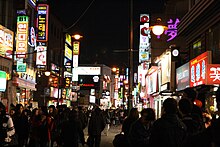Daehangno
You can help expand this article with text translated from the corresponding article in Korean. (February 2024) Click [show] for important translation instructions.
|
| Daehang-no | |
 Daehang-no at night | |
| Korean name | |
|---|---|
| Hangul | 대학로 |
| Hanja | |
| Revised Romanization | Daehangno |
| McCune–Reischauer | Taehangno |
| Formerly known as | |
| Hangul | 숭교방 |
| Hanja | |
| Revised Romanization | Sunggyobang |
| McCune–Reischauer | Sungkyopang |
Daehang-no (Korean: 대학로; lit. college street) is a area in Seoul north of the Han River within Jongno and Seodaemun districts.
Formerly known as Sunggyo-bang (숭교방; 崇敎坊; lit. high respect for teaching), it received its current name after the 1.1 km six lane road from Hyehwa-dong rotary to Ihwa-dong crossroad was designated as a "street of culture" on May 5, 1985.[citation needed]
Daehang-no is the street from the crossroad of 79–1, Jongno 5-ga, Jongno District, to Hyehwa-dong rotary, 132, Hyehwa-dong.[citation needed]
History
King Taejo relocated Sungkyunkwan to the current location on Daehang-no, after the founding of the Joseon dynasty. This gave Daehang-no its former name, "Sunggyo-bang", meaning "high respect for teaching".[citation needed]
During the Japanese occupation, Keijō Imperial University was founded in this area. The university was later merged with other colleges to form the prestigious Seoul National University.[citation needed]

